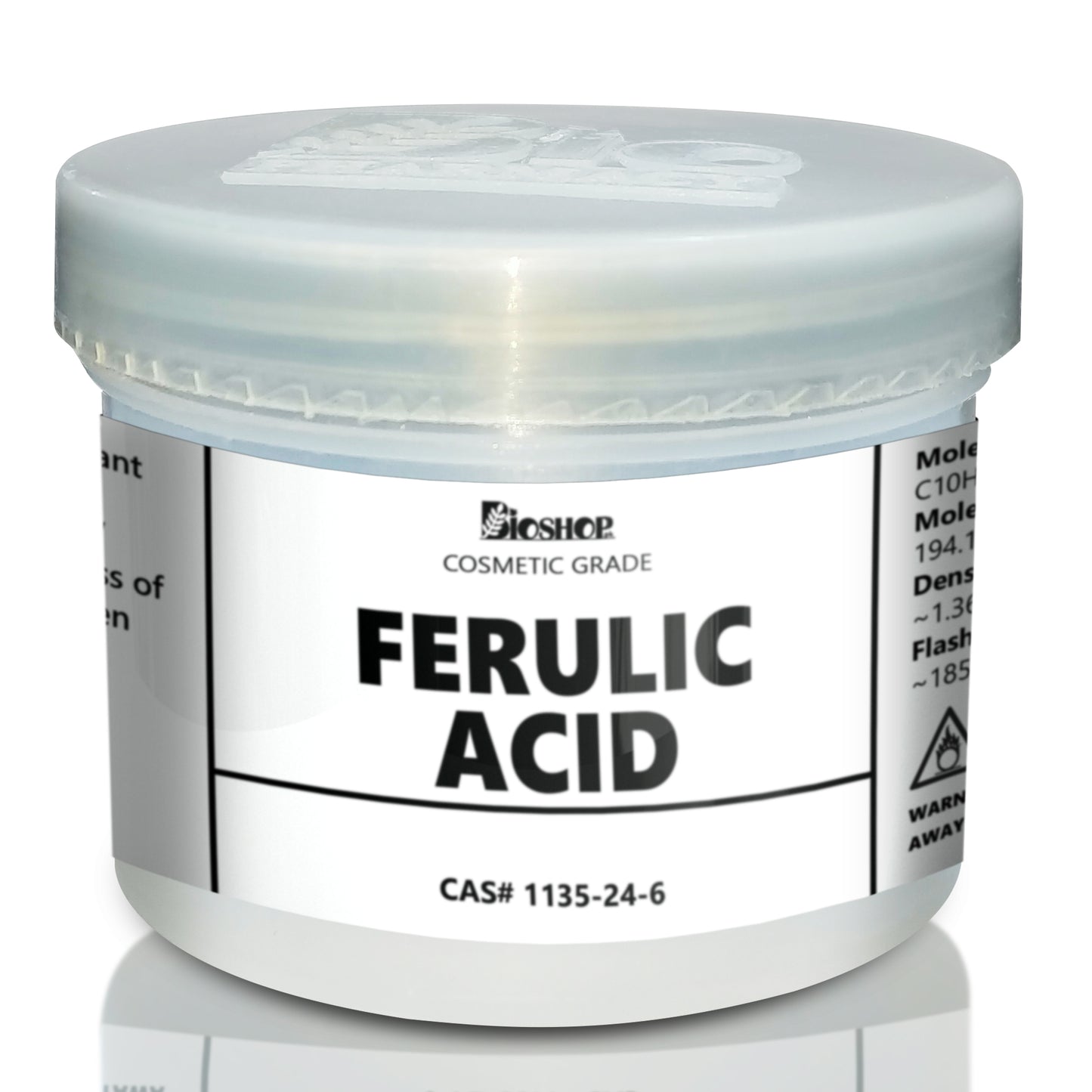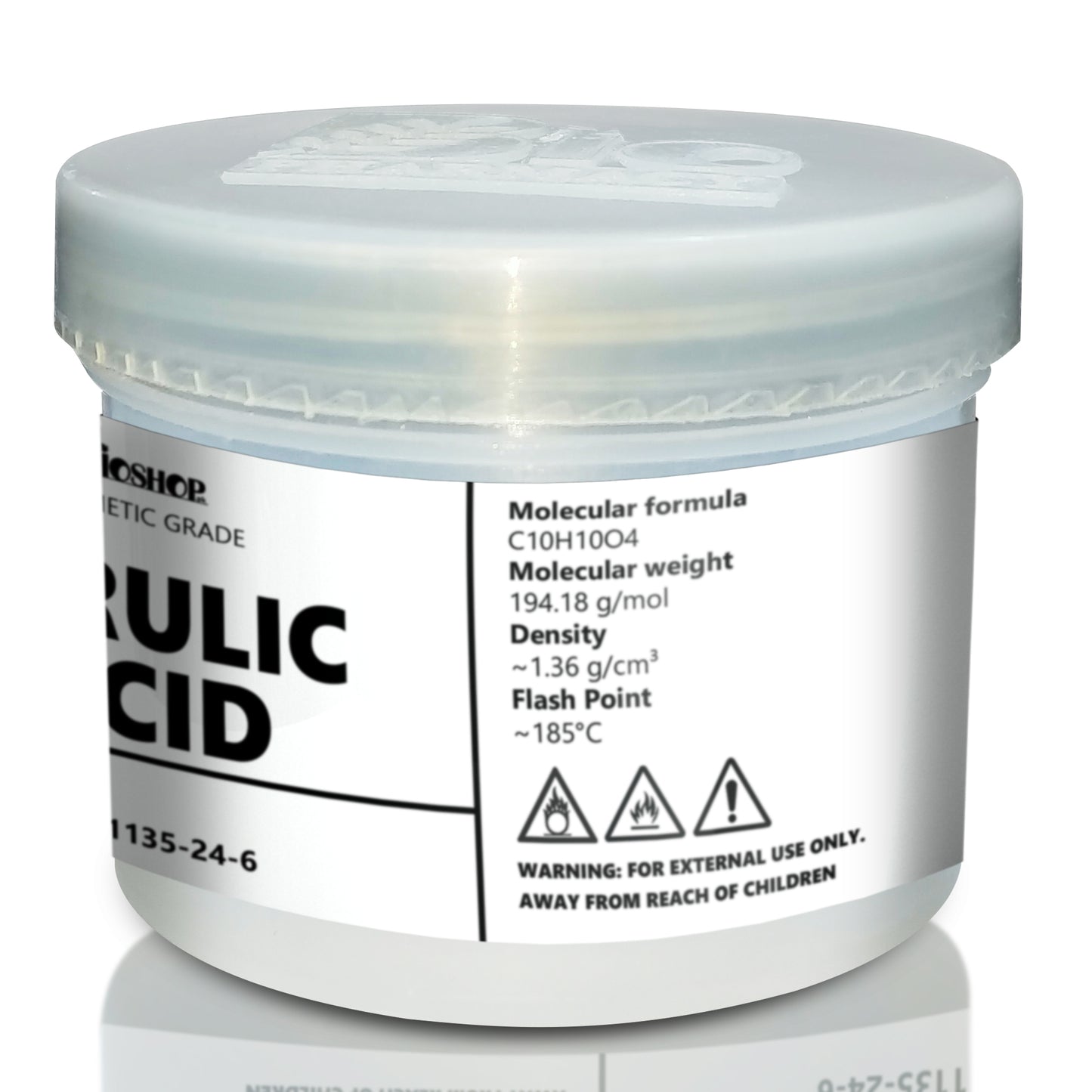Bio Shop
Ferulic Acid
Ferulic Acid
Key Functions: Acts as a high-performance antioxidant that boosts the efficacy and stability of Vitamins C and E in skincare.
Couldn't load pickup availability



Explore
Information About Ferulic Acid
✅ Key Features
- Neutralizes free radicals and UV-induced skin damage
- Enhances stability of L-Ascorbic Acid and Vitamin E
- Ideal for anti-aging, brightening, and photo-protection formulas
- Can improve skin tone and reduce fine lines
- Compatible with most actives in emulsions and serums
🔬 Description
Ferulic Acid is a naturally occurring phenolic antioxidant derived from rice bran, oats, and certain fruits and vegetables. It is most well-known in cosmetic science for its ability to stabilize and boost the performance of Vitamin C (Ascorbic Acid) and Vitamin E (Tocopherol) — making it a gold-standard ingredient in advanced antioxidant serums. In addition to neutralizing free radicals, Ferulic Acid can improve the appearance of uneven skin tone, reduce the look of fine lines, and prevent oxidative skin damage. It is particularly popular in photoprotective and anti-aging skincare formulas.
📊 Technical Data
INCI Name: Ferulic Acid
CAS Number: 1135-24-6
Solubility: Poorly soluble in water; soluble in ethanol, propylene glycol
Add Phase: Warm water phase with solubilizers
pH Stability: Best between pH 4.0–6.5
Processing Temperature: < 60°C
Appearance: Off-white to light yellow crystalline powder
Odor: Slightly sweet, earthy
Molecular Weight: 194.18 g/mol
Flash Point: 196°C
Boiling Point: Decomposes
Density: ~1.3 g/cm³
🧪 Recommended Usage
- Usage Rate: 0.3% – 1%
- Add to water phase using solubilizer (e.g., propanediol) or ethanol
- Best used in: Serums, Creams, Lotions, Anti-Aging Gels
💡 Pro Tip
🌞 Combine Ferulic Acid with 15% Vitamin C (L-Ascorbic Acid) and 1% Vitamin E (Tocopherol) for a powerful antioxidant serum that mimics luxury anti-aging products — but DIY at a fraction of the price. Store in amber or airless packaging to prevent degradation.
👩🔬 Skin Type Compatibility
✔️ Suitable for all skin types including mature, sensitive, oily, and combination skin
⚠️ Best used with pH monitoring and proper solubilization
🧴 Formulation Ideas
1. Advanced Antioxidant Serum
Create a brightening serum with 15% Vitamin C, 1% Vitamin E, and 0.5% Ferulic Acid. Dissolve Ferulic in a propanediol/glycerin mixture before combining with the water phase. Ideal for daytime use under sunscreen.
2. Anti-Aging Day Cream
Add Ferulic Acid into a pH-balanced emulsion containing peptides, niacinamide, and green tea extract. It boosts UV protection when worn under sunscreen.
3. Brightening Spot Treatment Gel
Formulate a lightweight gel with alpha arbutin, licorice root, and Ferulic Acid for targeted hyperpigmentation and antioxidant support.
4. Night Recovery Mask
Infuse a creamy overnight mask with Ferulic Acid, bakuchiol, and panthenol. It helps reduce signs of oxidative damage while the skin repairs overnight.
5. Eye Cream for Fine Lines
Use Ferulic at 0.3% with caffeine, panthenol, and peptides in an emollient base for an antioxidant-rich under-eye cream.
💧 Cosmetic Suitability:
Performance rating across key product types based on functionality, stability, and skin compatibility.
Serums
⭐⭐⭐⭐⭐ – Excellent
🟩🟩🟩🟩🟩 – Highly effective antioxidant for anti-aging and brightening serums.
Creams & Lotions
⭐⭐⭐⭐☆ – Good
🟩🟩🟩🟩⬜ – Works well in emulsions with pH control and proper solubilization.
Toners
⭐⭐☆☆☆ – Fair
🟧🟧⬜⬜⬜ – Can be used in alcohol-based or glycol-based toners with care.
Face Masks
⭐⭐⭐✨☆ – Between Moderate & Good
🟧🟧🟧🟧⬜ – Effective in overnight or cream mask formulas.
Cleansers
⭐⭐☆☆☆ – Fair
🟧🟧⬜⬜⬜ – Limited benefit due to rinse-off nature; not ideal for leave-on effect.
Hair Masks
⭐☆☆☆☆ – Poor
🟥⬜⬜⬜⬜ – Not relevant for haircare applications.
Deodorants
⭐☆☆☆☆ – Poor
🟥⬜⬜⬜⬜ – No real function in deodorant systems.
Eye Creams
⭐⭐⭐⭐☆ – Good
🟩🟩🟩🟩⬜ – Great for antioxidant protection in under-eye formulations.
Shampoos
☆☆☆☆☆ – Not Suitable
🟥🟥⬜⬜⬜ – Not recommended for rinse-off scalp or hair care.
Soaps
☆☆☆☆☆ – Not Suitable
🟥⬜⬜⬜⬜ – Not compatible with high pH environments.
Conditioners
⭐☆☆☆☆ – Poor
🟥⬜⬜⬜⬜ – Minimal relevance in haircare emulsions.
Lip Balms
⭐⭐☆☆☆ – Fair
🟧🟧⬜⬜⬜ – Potential antioxidant support; not commonly used.
Body Butters
⭐⭐✨☆☆ – Between Fair & Moderate
🟧🟧🟧⬜⬜ – Can support antioxidant protection in rich formulas.
❓ FAQs
Q1: Can Ferulic Acid be used in water-based serums?
A1: Not directly — Ferulic Acid is poorly water-soluble. It requires solubilizers like propylene glycol, propanediol, or ethanol to properly dissolve and stay stable in formulas.
Q2: Is Ferulic Acid safe for daily use?
A2: Yes! When used at 0.3–1% concentration in well-formulated products, it is safe for daily use, especially when combined with other antioxidants like Vitamin C and E.
Q3: Does Ferulic Acid need a preservative?
A3: Ferulic Acid itself is not a preservative. Your formula still requires a full-spectrum preservative system to protect against microbial growth.
Q4: Can I mix Ferulic Acid with Vitamin C at home?
A4: Yes, but with caution. DIY Vitamin C + Ferulic Acid serums require accurate pH control (around 3.2–3.5), proper solubilizers, and opaque/airless packaging to remain stable and effective.
Q5: Will Ferulic Acid oxidize or change color over time?
A5: Yes, especially in the presence of air, light, or high temperature. Store in amber bottles or airless pumps in a cool, dark place to maximize shelf life.
📂 Documentation
Upon request, we will provide.
Where Can You Safely Use Ferulic Acid
Discover how Ferulic Acid performs across different products — rated for safety, stability, and effectiveness.




